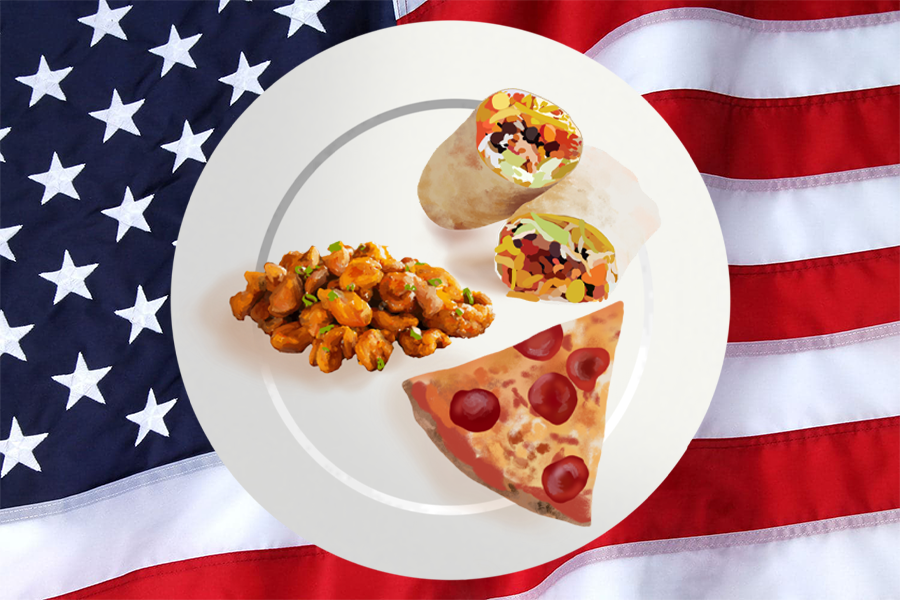Immigration’s legacy: the Americanization of food
Pizza, orange chicken, and burritos are three notable cultural foods that have been Americanized.
February 6, 2023
Burgers, hot dogs, you name it. To many, food is an integral component of the American identity. Much of the American palette today is rooted in decades of immigration and globalization. As people around the world bring their flavors to the U.S., foreign dishes have become Americanized, infusing American preferences with multi-cultural appreciation.
In America’s sea of diverse cultural foods, true American cuisine does exist through dishes that were born in the U.S. Invented in the South, dishes like Shrimp and Grits, Hoppin’ John and Gumbo were highly influenced by African culture often brought by descendents of African slaves. New England’s early abundance of fishing industries led to the rise of iconic seafood dishes such as clam chowder, lobster roll and fried clams. Early colonists learned recipes like Succotash and Johnnycakes from Native Americans. Still, a majority of food in the U.S. is transferred or inspired from other countries due to immigration. As immigrant restaurateurs adapted to the American culture and economy, they have altered traditional dishes to conform to local tastes in order to make a living. Here is the history of Americanized food from America’s top three most popular ethnic cuisines:
Americanized Chinese Food
Chinese immigrants first began modifying recipes because authentic ingredients, especially vegetables, were not available in the U.S. A dish that had an ingredient substitution was beef and broccoli; 19th and 20th century Chinese immigrants in San Francisco swapped broccoli for gailan, a Chinese variant of broccoli, because they couldn’t find it in America.
To accommodate the Western palette, immigrants swapped unfamiliar ingredients in their dishes, especially exotic animals and their parts, with more familiar meats. For example, meats like chicken or beef replaced animal intestines in chop suey in order for restaurateurs to avoid controversy and adapt to local eating preferences.
While many Chinese-American foods are adaptations of recipes from China, Chinese-American cuisine has invented iconic dishes of its own. Orange chicken, invented by the fast-casual chain Panda Express in America, was inspired by China’s iconic sweet and sour flavors and is a variation of General Tso’s chicken, another Americanized dish. A popular dessert in Chinese-American restaurants, fortune cookies were created in California with unclear cultural origins. Even though foods like orange chicken and fortune cookies will not be found in China, the meals have established themselves as an integral part of the Chinese-American palette.
Americanized Mexican Food
Mexican-American food largely refers to Tex-Mex cuisine, which was developed by Tejanos, the first Spanish settlers in Texas from the 16 th century. Having a Mexican style, Tex-Mex cuisine elicits American flavors with its hefty use of cheese and more diverse spices. Some classic Tex-Mex recipes include chili con carne and chimichangas.
th century. Having a Mexican style, Tex-Mex cuisine elicits American flavors with its hefty use of cheese and more diverse spices. Some classic Tex-Mex recipes include chili con carne and chimichangas.
Burritos are a quintessential Mexican-American food. In Mexico, burritos are packed with meat, beans, cheese and salsa. Its American counterpart is much more loaded, containing fillings such as rice, lettuce andsour cream. American burritos will rarely be found in Mexico, only appearing in tourist regions. Tacos, on the other hand, are much more common in Mexico.
Mexican restaurants make up a large portion of America’s food industry, particularly in the form of food chains. Chains like TacoBell and Chipotle are big names in the fast-food sphere, and have helped to popularize Mexican-American food domestically and internationally.
Americanized Italian Food
From pizza to pasta, Italian cuisine has cemented itself into the American palette. During the late 19th century, Italian immigrants settled in America to escape famine and unemployment; however, it wasn’t until the late 20th century that Italian food became socially accepted and popularized due to foreign tastes and class divisions.
Many Italian-American dishes contrast from their Italian counterparts because of how meat was more abundant and affordable in the U.S. An Italian-American staple, spaghetti and meatballs are served separately as individual dishes in Italy instead of together. For the same reason, chicken parmigiana was invented as an iteration of eggplant parmigiana. Sauces have also been developed by Italian Americans — The sauce of American fettuccine alfredo is much heavier than its Italian version, and Italian dressing received its name and flavor from its Italian herbs and seasonings like oregano, basil and garlic.
Standing as one of the most essential foods in American society, pizza has been profusely Americanized. Pepperoni is an entirely American meat, and pineapple as a topping is practically unheard of in Italy. Italian pizza has one or no toppings, compared to America’s loaded pizzas. While American pizza has a range of thin and thick crusts, Italian pizza only has a very thin crust. Finally, American pizza has expanded to dozens of variations, from Chicago and New York-style pizza to pizza bagels and rolls.
–
The evolution of food in America has come a long way from the colonial era to today. Especially in a country of such diverse cultures, food is always adapting to society’s social, economic and political changes. Food is a unifier and a form of cultural expression; understanding and appreciating the traditions in which foods originated from is key to acknowledging America’s history of immigration and abundance of cultures.



































































